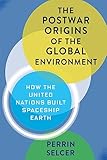The Postwar Origins of the Global Environment : How the United Nations Built Spaceship Earth / Perrin Selcer.
Material type: TextSeries: Columbia Studies in International and Global HistoryPublisher: New York, NY : Columbia University Press, [2018]Copyright date: ©2018Description: 1 online resource : 12 b&w illustrationsContent type:
TextSeries: Columbia Studies in International and Global HistoryPublisher: New York, NY : Columbia University Press, [2018]Copyright date: ©2018Description: 1 online resource : 12 b&w illustrationsContent type: - 9780231166485
- 9780231548236
- Environmental policy -- International cooperation -- History -- 20th century
- Environmentalism -- International cooperation -- History -- 20th century
- Internationalism -- History -- 20th century
- Science -- International cooperation -- History -- 20th century
- World politics -- 1945-1989
- POLITICAL SCIENCE / Intergovernmental Organizations
- 363.7/0526
- GE195
- online - DeGruyter
- Issued also in print.
| Item type | Current library | Call number | URL | Status | Notes | Barcode | |
|---|---|---|---|---|---|---|---|
 eBook
eBook
|
Biblioteca "Angelicum" Pont. Univ. S.Tommaso d'Aquino Nuvola online | online - DeGruyter (Browse shelf(Opens below)) | Online access | Not for loan (Accesso limitato) | Accesso per gli utenti autorizzati / Access for authorized users | (dgr)9780231548236 |
Browsing Biblioteca "Angelicum" Pont. Univ. S.Tommaso d'Aquino shelves, Shelving location: Nuvola online Close shelf browser (Hides shelf browser)

|

|

|

|

|

|

|
||
| online - DeGruyter Positioning for Advantage : Techniques and Strategies to Grow Brand Value / | online - DeGruyter The Life of Imagination : Revealing and Making the World / | online - DeGruyter Buying Gay : How Physique Entrepreneurs Sparked a Movement / | online - DeGruyter The Postwar Origins of the Global Environment : How the United Nations Built Spaceship Earth / | online - DeGruyter Nuclear North Korea : A Debate on Engagement Strategies / | online - DeGruyter Disrespectful Democracy : The Psychology of Political Incivility / | online - DeGruyter Absence in Cinema : The Art of Showing Nothing / |
Frontmatter -- Contents -- Acknowledgments -- Abbreviations -- Introduction. Science, Global Governance, And The Environment -- 1. Behind The Burlap Curtain -- 2. Conserving The World Community -- 3. Men Against The Desert -- 4. The Soil Map Of The World And The Politics Of Scale -- 5. Locating The Global Environment -- 6. Spaceship Earth In The Age Of Fracture -- Conclusion. The View From A Utopia'S Ruins -- Notes -- Bibliography -- Index
restricted access online access with authorization star
http://purl.org/coar/access_right/c_16ec
In the wake of the Second World War, internationalists identified science as both the cause of and the solution to world crisis. Unless civilization learned to control the unprecedented powers science had unleashed, global catastrophe was imminent. But the internationalists found hope in the idea of world government. In The Postwar Origins of the Global Environment, Perrin Selcer argues that the metaphor of "Spaceship Earth"-the idea of the planet as a single interconnected system-exemplifies this moment, when a mix of anxiety and hope inspired visions of world community and the proliferation of international institutions.Selcer tells the story of how the United Nations built the international knowledge infrastructure that made the global-scale environment visible. Experts affiliated with UN agencies helped make the "global"-as in global population, global climate, and global economy-an object in need of governance. Selcer traces how UN programs such as UNESCO's Arid Lands Project, the production of a soil map of the world, and plans for a global environmental-monitoring system fell short of utopian ambitions to cultivate world citizens but did produce an international community of experts with influential connections to national governments. He shows how events and personalities, cultures and ecologies, bureaucracies and ideologies, decolonization and the Cold War interacted to make global knowledge. A major contribution to global history, environmental history, and the history of development, this book relocates the origins of planetary environmentalism in the postwar politics of scale.
Issued also in print.
Mode of access: Internet via World Wide Web.
In English.
Description based on online resource; title from PDF title page (publisher's Web site, viewed 29. Mrz 2022)


